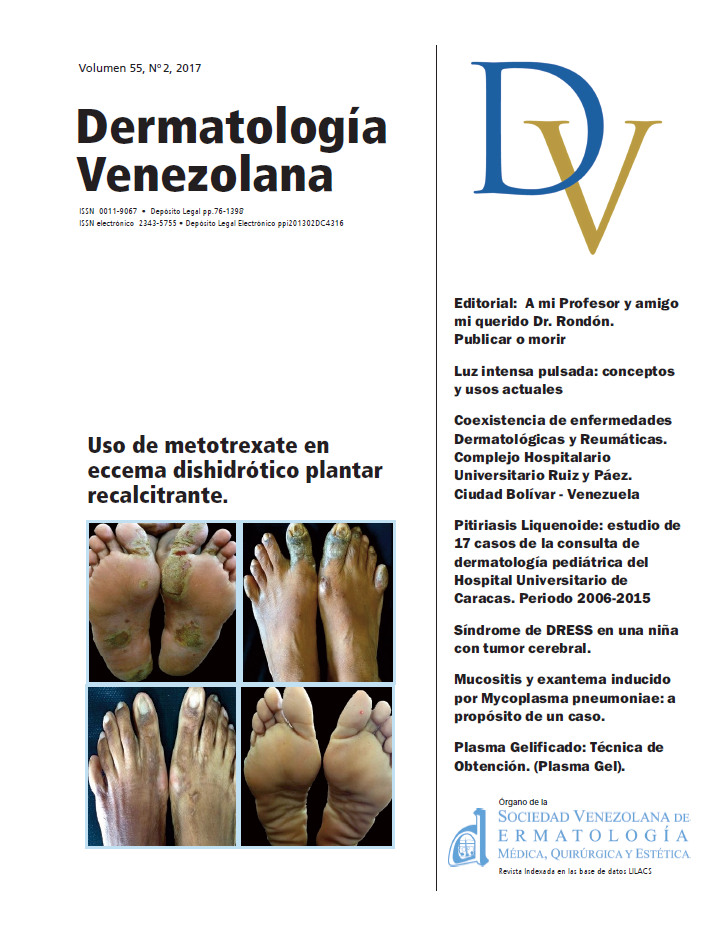Síndrome de Dress en una niña con tumor cerebral
Palabras clave:
Síndrome DREES, hipersensibilidad a medicamentos, carbamazepinaResumen
El síndrome DRESS (Reacción a fármacos con eosinofilia y síntomas sistémicos) es una toxidermia sistémica poco frecuente, caracterizada principalmente por rash, fiebre, disfunción hepática y eosinofilia. Se puede presentar luego de la exposición a ciertos fármacos, con una elevada mortalidad entre el 10% y 30 % de los casos. El diagnóstico no es tan sencillo, por la amplia variedad en la presentación clínica y pruebas de laboratorio. Generalmente, las enfermedades de base y comorbilidades afectan el curso natural y empeoran el pronóstico. Se presenta el caso, de una niña que desarrolla síndrome de DRESS durante su hospitalización en cuidado intensivo.
Summary
DRESS Syndrome in a child with brain tumor.
DRESS syndrome (Drug Rash with Eosinophilia and Systemic Symptoms) is a rare systemic toxidermia, characterized mainly by rash, fever, hepatic dysfunction and eosinophilia. It can occur after exposure to certain drugs, with an elevated mortality between 10% and 30% of cases. Because of the wide variety of clinical presentation and laboratory tests, the diagnosis is not easy. Generally, the underlying diseases and comorbidities affect the natural course and complicate the prognosis. We present the case of a girl who develops DRESS syndrome during her hospitalization in intensive care.
Key words: DRESS syndrome; drug hypersensitivity; carbamazepine.
Referencias
Shiohara, T. & Kano, Y. Drug reaction with eosinophilia and systemic symptoms ( DRESS ): incidence , pathogenesis and management. Tetsuo Shiohara & Yoko Kano (2016), Expert Opinion on Drug Safety, 2017.12.4-35
Torres M. & Olmos E. Reacciones medicamentosas severas Severe drug reactions. Acta Med Colomb 2013; 38: 76-82
Silva-feistner, M. & Ortiz, E. Síndrome de sensibilidad a fármacos con eosinofilia y síntomas sistémicos en pediatría . Caso clínico DRESS syndrome in paediatrics . Clinical case. 88, 158–163 (2017).
Sofi, C., Vieira, A. M. & Oliveira, A. P. Rare disease DRESS syndrome : a case report and literature review.02.2011.3898, 2–5
Kardaun, S. H. et al. Drug reaction with eosinophilia and systemic symptoms ( DRESS ): an original multisystem adverse drug reaction . Results from the prospective RegiSCAR study. 1071–1080 (2013).
Husain Z, Reddy BY, Schwartz RA (2013) DRESS syndrome: Part II. Manage-ment and therapeutics. J Am Acad Dermatol 2013, 68:709.e1–709.e9
Ahluwalia J, Abuabara K, Perman MJ, Yan AC. Human herpesvirus 6 involvement in paediatric drug hypersensitivity syndrome. Br J Dermatol. 2016.172:1090–1095
Husain, Z., Reddy, B. Y., Schwartz, R. A. & Edin, F. DRESS syndrome Part I. Management and therapeutics. J. Am. Dermatology 2013 68, 709.e1–709.e9
Roujeau, J. & Haddad, C. Management of Nonimmediate Hypersensitivity Reactions to Drugs. Immunol Allergy Clin N Am 34 (2014) 473–487
Jimena Muciño-Bermejo, Manuel Díaz de León-Ponce, Carlos Gabriel Briones et al. Rev Med Inst Mex Seguro Soc. 2013;51(3):330-5
Descargas
Archivos adicionales
Publicado
Número
Sección
Licencia
Publicado por la Sociedad Venezolana de Dermatología Médica, Quirúrgica y Estética







